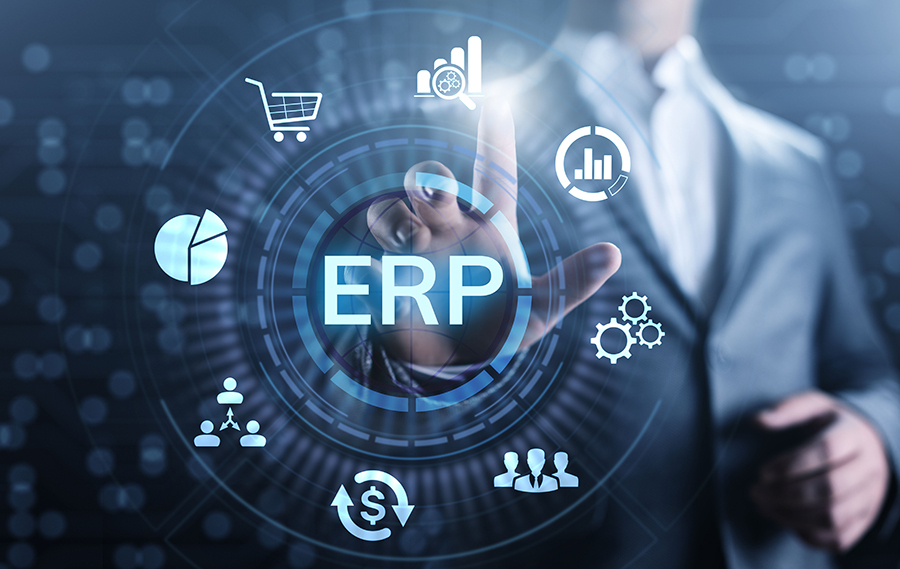Enterprise resource planning (ERP) is a system used by businesses to streamline and optimize operations. A company comprises of many individual units that work together towards a common interest, such as procuring and purchasing, sales, finance, marketing, planning, and human resources. An ERP software integrates and manages these core units under a single system. It is the central hub through which all branches of a business are interconnected.
An ERP software allows all branches of a business to communicate and share important data. It collects the company’s data from multiple divisions, eliminating costly data duplication by placing it under a single source open for all. It promotes time and cost-effective practices by creating a smooth flow of operations. It is especially essential for larger companies with multiple divisions. However, with the ever-changing customer demands and global economy, smaller businesses are integrating ERP systems into their businesses as well.
Functions of an ERP Software
ERP systems consist of various modules that perform both back-and-front office functions like:
- Finance and accounting- The finance and accounting module of an ERP software performs one of the most key functions. It allows you to understand and manage your finances in one place and gives you the tools to forecast future financial outcomes.
- Procurement and purchasing- It simplifies the purchasing procedure for materials a company needs to manufacture or sell goods. It also sends notifications when stocks are low so that the company can send out purchase orders if required.
- Manufacturing- The manufacturing module gives real-time data on raw materials, in-process goods, and finished products. This module helps manufacturers plan and track production schedules by monitoring the raw material quantities and machine capacity. It can also calculate the average manufacturing time for a batch.
- Inventory management- This module tracks and monitors the quantities and location of inventory items.
- Order management- The order management module tracks the order from the time that it is placed to the moment that it is shipped out to the customer. This prevents delays or items from getting lost.
- Customer relationship management (CRM)- This module’s main function is to improve customer service. It stores data from customer interactions and customer purchase history, which is then used to enhance customer experience.
- Human resource management (HRM)- The human resource or human capital management module records employee personal data, performance reviews, offer letters, job descriptions, sick days, and leaves. Since all information is stored in one place, it eliminates duplication and reduces the risks of errors.
- Workforce management- The workforce management module is a lot similar to the human resources management (HRM) module. The main difference is that the workforce module is mainly designed for companies with hourly paid employees rather than fixed salaried employees. It monitors the attendance, hours, and productivity of the employees.
Important Features to Look for When Choosing an ERP Software
When choosing an ERP solution for your business, evaluate if its features and modules are sufficient for your company’s unique needs. Keep the following points in mind when searching for a suitable ERP solution:
- Inventory Tracking
An efficient ERP inventory management system is crucial for a well-organized enterprise or a small business. Opting for an ERP system which can manage inventory, finances, logistics, and operational process in one place will save your money and time. It will also help you collect important data which can be used to understand the supply and demand balance, forecast product sales, and increase customer satisfaction.
- Automation
Complete process automation can increase accuracy, save time, increase productivity, and lower costs. Automation increases information reliability by ensuring accurate data entry and minimizing the risk of errors. With a singular system managing every aspect of your business, you will not need to purchase individual document management systems for every division. This will also minimize the need for manual time-consuming operations, saving you both time and money.
- Financial Management
When choosing an ERP software, opt for one that has a robust financial and accounting feature. Employ software that can ensure the secure storage, control, and analysis of your financial data. The financial management feature should include budget analysis and offer strategies to optimize your expenditures. This is one of the most important features that will help you reduce costs, devise better plans, and increase profits.
- Security
The most fundamental feature that an ERP system should possess is security. None of the fancy features of ERP software offers will be of any use if your information is not safe and secure. An ERP system records, stores, and manages all of your company’s data from employee records to finances, keeping this information secure is of the utmost importance for any company.
Type of ERP Software
There are three basic types of ERP systems:
- Cloud-based- In a cloud-based ERP system, the vendor manages and hosts the services remotely offsite in the cloud.
- On-premise- Contrary to cloud-based ERP, on-premise ERP systems are operated within the organization’s premises rather than remotely offsite.
- Hybrid- A hybrid or a two-tier ERP system hosts some services remotely in the cloud and some services on-premise.
Conclusion
In this day and age, with the current economic and technological evolution, it is near impossible to run a large enterprise without integrating an ERP solution. Refusing to adapt to these essential requirements will only stunt your company’s growth, decrease productivity, and increase expenditures.
No matter what services your company offers, an ERP system can improve your workflow, save time, improve communication, increase flexibility, optimize operations, and grow profits.

Leave a Reply